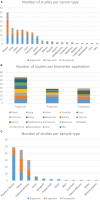A Timely Shift from Shotgun to Targeted Proteomics and How It Can Be Groundbreaking for Cancer Research
- PMID: 28265552
- PMCID: PMC5316539
- DOI: 10.3389/fonc.2017.00013
A Timely Shift from Shotgun to Targeted Proteomics and How It Can Be Groundbreaking for Cancer Research
Abstract
The fact that cancer is a leading cause of death all around the world has naturally sparked major efforts in the pursuit of novel and more efficient biomarkers that could better serve as diagnostic tools, prognostic predictors, or therapeutical targets in the battle against this type of disease. Mass spectrometry-based proteomics has proven itself as a robust and logical alternative to the immuno-based methods that once dominated the field. Nevertheless, intrinsic limitations of classic proteomic approaches such as the natural gap between shotgun discovery-based methods and clinically applicable results have called for the implementation of more direct, hypothesis-based studies such as those made available through targeted approaches, that might be able to streamline biomarker discovery and validation as a means to increase survivability of affected patients. In fact, the paradigm shifting potential of modern targeted proteomics applied to cancer research can be demonstrated by the large number of advancements and increasing examples of new and more useful biomarkers found during the course of this review in different aspects of cancer research. Out of the many studies dedicated to cancer biomarker discovery, we were able to devise some clear trends, such as the fact that breast cancer is the most common type of tumor studied and that most of the research for any given type of cancer is focused on the discovery diagnostic biomarkers, with the exception of those that rely on samples other than plasma and serum, which are generally aimed toward prognostic markers. Interestingly, the most common type of targeted approach is based on stable isotope dilution-selected reaction monitoring protocols for quantification of the target molecules. Overall, this reinforces that notion that targeted proteomics has already started to fulfill its role as a groundbreaking strategy that may enable researchers to catapult the number of viable, effective, and validated biomarkers in cancer clinical practice.
Keywords: biomarkers; cancer; diagnosis; mass spectrometry; targeted proteomics.
Figures


Similar articles
-
Urinary biomarkers in prostate cancer detection and monitoring progression.Crit Rev Oncol Hematol. 2017 Oct;118:15-26. doi: 10.1016/j.critrevonc.2017.08.002. Epub 2017 Aug 19. Crit Rev Oncol Hematol. 2017. PMID: 28917266 Review.
-
In-depth proteomics of ovarian cancer ascites: combining shotgun proteomics and selected reaction monitoring mass spectrometry.J Proteome Res. 2011 May 6;10(5):2286-99. doi: 10.1021/pr1011087. Epub 2011 Apr 14. J Proteome Res. 2011. PMID: 21491939
-
Verification of the biomarker candidates for non-small-cell lung cancer using a targeted proteomics approach.J Proteome Res. 2015 Mar 6;14(3):1412-9. doi: 10.1021/pr5010828. Epub 2015 Feb 9. J Proteome Res. 2015. PMID: 25597550
-
Human tear proteomics and peptidomics in ophthalmology: Toward the translation of proteomic biomarkers into clinical practice.J Proteomics. 2017 Jan 6;150:359-367. doi: 10.1016/j.jprot.2016.05.006. Epub 2016 May 13. J Proteomics. 2017. PMID: 27184738 Review.
-
Large-scale clinical validation of biomarkers for pancreatic cancer using a mass spectrometry-based proteomics approach.Oncotarget. 2017 Jun 27;8(26):42761-42771. doi: 10.18632/oncotarget.17463. Oncotarget. 2017. PMID: 28514751 Free PMC article.
Cited by
-
Longitudinal Stroke Recovery Associated With Dysregulation of Complement System-A Proteomics Pathway Analysis.Front Neurol. 2020 Jul 28;11:692. doi: 10.3389/fneur.2020.00692. eCollection 2020. Front Neurol. 2020. PMID: 32849183 Free PMC article.
-
Multiple Reaction Monitoring-Based Targeted Assays for the Validation of Protein Biomarkers in Brain Tumors.Front Oncol. 2021 May 14;11:548243. doi: 10.3389/fonc.2021.548243. eCollection 2021. Front Oncol. 2021. PMID: 34055594 Free PMC article.
-
Cancer-Associated Membrane Protein as Targeted Therapy for Bladder Cancer.Pharmaceutics. 2022 Oct 18;14(10):2218. doi: 10.3390/pharmaceutics14102218. Pharmaceutics. 2022. PMID: 36297654 Free PMC article. Review.
-
Proteomics advances for precision therapy in ovarian cancer.Expert Rev Proteomics. 2019 Oct;16(10):841-850. doi: 10.1080/14789450.2019.1666004. Epub 2019 Sep 13. Expert Rev Proteomics. 2019. PMID: 31512530 Free PMC article. Review.
-
Re-mining serum proteomics data reveals extensive post-translational modifications upon Zika and dengue infection.Mol Omics. 2023 May 9;19(4):308-320. doi: 10.1039/d2mo00258b. Mol Omics. 2023. PMID: 36810580 Free PMC article.
References
Publication types
LinkOut - more resources
Full Text Sources
Other Literature Sources
Miscellaneous

